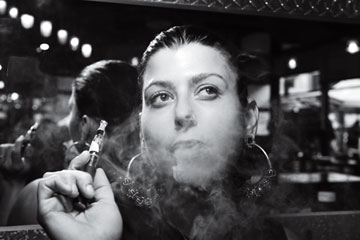
(6 of 7)
Weiss has also recruited a former Surgeon General as well as a former head of the tobacco-research arm of the National Cancer Institute, Scott Leischow, who did a study in which 16% of e-cigarette smokers quit by the end of the study period and 89% reduced smoking consumption. Meanwhile, researchers at the Harvard School of Public Health and the University of Massachusetts at Boston found last year that smokers who used nicotine-replacement therapy, including nicotine gum and the patch, were just as likely to relapse as those who used nothing at all. Referring to a Morgan Stanley estimate, Weiss argues that 2.4 billion fewer cigarettes are smoked every year because of electronic cigarettes. That's a point of pride at NJOY. A flyer circulated internally among employees says, "100 million cigarettes not smoked and counting," with this tagline: "Cigarettes. You've met your f---ing match."
Weiss's emphasis on the health of the product is daring. NJOY helped convince a federal appeals court that the FDA shouldn't be allowed to regulate electronic cigarettes as a medicine--regulations that would have involved expensive clinical trials--so long as the companies selling them didn't claim they could help you quit. Here NJOY has to walk a fine line between making explicit cessation claims and implying health benefits to encourage new users and stave off local regulations. He says indoor-smoking bans--like, for example, the one already passed in Boston--are "not in the public health's best interest," and he calls fears that kids might start using the product a "bogeyman."
But some scientists who are not on Weiss's staff--even those who are optimistic about the promise of e-cigarettes--are not so quick to dismiss the dangers. The public-health community has PTSD from the two times in history the tobacco industry promised its products were healthier--light and filtered cigarettes, both of which turned out to be just as deadly. No one really thinks electronic cigarettes are more of the same. There are more than 7,000 chemicals in a combustible cigarette and no more than a handful in e-cigs. But even the most supportive doctors say indoor bans make sense. Nonsmokers have a right to breathe air that doesn't contain nicotine, they say, and there is not enough information on the effects of breathing in propylene glycol or the fine particles e-cigarettes put into the air.
"The studies the e-cigarette people point out, claiming these things are harmless, are really, really, really crappy," says Stanton Glantz, a professor at the University of California, San Francisco, medical school and a leading expert on the effects of secondhand tobacco smoke. "It is probably about 10% to 20% of what a cigarette puts out, so looked at that way, they are really nice. On the other hand, if you look at absolute levels of risk, they are pretty bad, because a cigarette is just ridiculously toxic and ridiculously polluting. If you go into a bar or casino where there is a lot of smoking, the only way to get the air that polluted outdoors is to be downwind from a large forest fire. If you say an electronic cigarette is only 10% to 20% less polluting than a massive forest fire, that's not so good." Weiss's Princeton scientist, Rabinowitz, counters that the level of pollution an NJOY emits is 100 to 10,000 times lower than OSHA's indoor-pollution standards.
